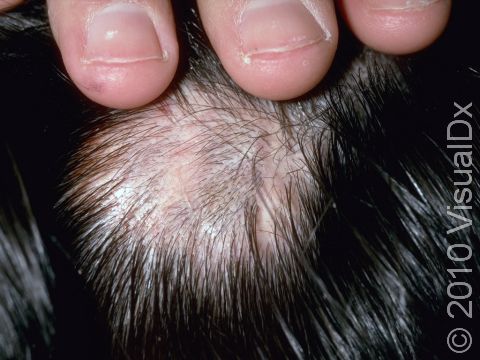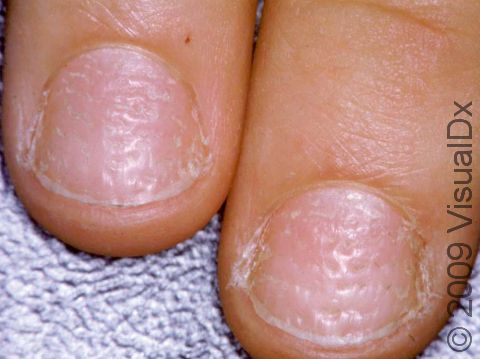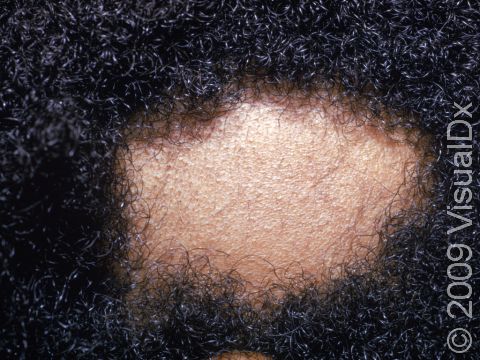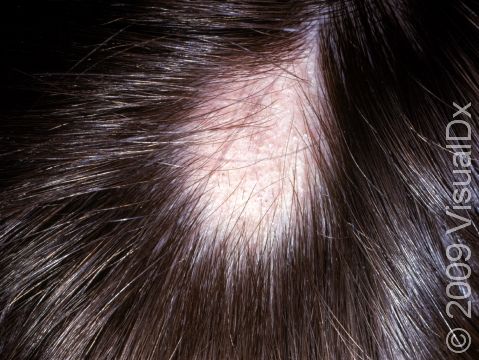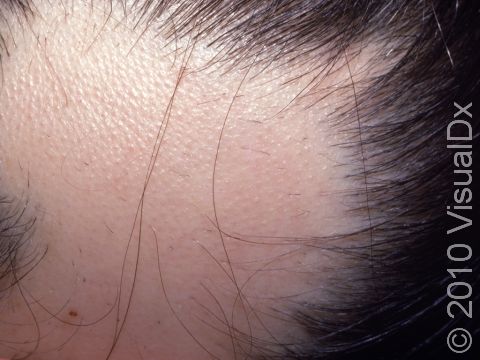Hair Loss (Alopecia Areata)
Alopecia areata is an autoimmune condition resulting in hair loss. The body’s immune system mistakenly targets the hair follicle and stops hair growth. The cause is unknown, but genetic and environmental factors may play a role. Hair loss may be confined to one or two small bald patches (flat, smooth areas larger than a thumbnail), or it may involve most of the scalp. It can also affect the eyebrows, eyelashes, beard, and other body sites, or it may involve the whole body. In most people, hair regrows spontaneously, although recurrences of the condition are also typical.
Who's At Risk?
Alopecia areata can occur in any age, race / ethnicity, and sex. The most frequent association is with thyroid disease, but it may also be seen in those with lupus, lichen planus, vitiligo, and Down syndrome.
Signs & Symptoms
Hair loss most commonly occurs on the scalp, but it can also target other body sites. Signs and symptoms may include round, patchy areas of nonscarring hair loss, ranging from mild to severe.
- Mild: 1-5 scattered areas of hair loss on the scalp and beard
- Moderate: More than 5 scattered areas of hair loss on the scalp and beard
- Severe: loss of all the hair on the scalp and body
The affected areas of the scalp may have a burning sensation.
Hairs that do grow back may be either temporarily or permanently white. This color change is not seen in other forms of alopecia.
Pits and ridges in the fingernails can also occur.
Self-Care Guidelines
Psychological support may be beneficial.
Wigs may be worn to camouflage hair loss.
Treatments
The doctor may prescribe topical or oral (systemic) medications as well as injections. Steroid injections may help speed up hair regrowth (including in children) with mild-to-moderate conditions:
- A powerful (potent) topical steroid (clobetasol propionate [Clobex, Cormax] gel or solution) can be applied every 12 hours, with or without covering the area (occlusion) overnight. (Note: Clobetasol lotion, shampoo, and spray are not recommended for use in patients younger than age 18 years.)
- Anthralin (Drithocreme) cream 1%, a topical medicine, can activate (stimulate) the immune system to speed up healing. Apply this medication to the affected area and about 1 cm beyond the border for 10-20 minutes, and then wash it off with shampoo (age 12 years and older).
- For more extensive disease, your doctor may expose the affected area to light or apply topical steroids plus minoxidil (Loniten, Minodyl), each used every 12 hours.
- Systemic steroids, such as prednisone, may be prescribed, although they have no long-term benefit and are not recommended for use beyond the short-term.
- Janus kinase (JAK) inhibitors (eg, baricitinib [Olumiant]) are a newer class of prescription medications that may be prescribed in severe cases that are not responding to other treatments (age 12 years and older).
Visit Urgency
People experiencing areas of patchy hair loss are advised to seek evaluation from a primary care provider or dermatologist.
References
Bolognia J, Schaffer JV, Cerroni L. Dermatology. 4th ed. Philadelphia, PA: Elsevier; 2018.
James WD, Elston D, Treat JR, Rosenbach MA. Andrew’s Diseases of the Skin. 13th ed. Philadelphia, PA: Elsevier; 2019.
Kang S, Amagai M, Bruckner AL, et al. Fitzpatrick’s Dermatology. 9th ed. New York, NY: McGraw-Hill Education; 2019.
Paller A, Mancini A. Paller and Mancini: Hurwitz Clinical Pediatric Dermatology. 6th ed. St. Louis, MO: Elsevier; 2022.
Last modified on June 13th, 2024 at 5:08 pm

Not sure what to look for?
Try our new Rash and Skin Condition Finder
